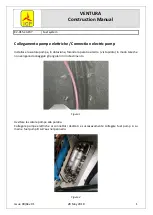
AEROPRAKT-32 Pilot Operating Handbook
A32-240-POH
35
(3/32 in) cables, passing through a system of pulleys, two inner and two outer bellcranks,
two inner and two outer pushrods.
Fig. 7. Control system of flaperons (drooping ailerons)
The control force in roll applied by the pilot to the yoke 1 is passed via the pushrods (2) to
the bellcrank (3) located on the control column (4). Then via the cables (5) the force is
passed to the inner right (6) and left (7) bellcranks, via the inner pushrods (8) to the outer
right (9) and left (10) bellcranks. Then the control force is passed from the outer bellcranks
to the flaperons via the outer pushrods (11). The inner bellcranks hinged on the flap
extension mechanism beam (12) are connected to each other with the pushrod (13). The
cables are routed using two pulleys (14) on the control column, two pulleys (15) aft of the
frame No.3 low in the middle, two pulleys (16) aft of the frame No.3 low on the sides, and
two pulleys (17) on the frame No.3 up near the rear wing attachment points.
The cable tension and flaperon position adjustment is achieved using the turnbuckles (18)
located near the inner bellcranks (7).
Deflection angles of the flaperons (as ailerons): up
– 15.5±1°, down – 11.1±1°.
The aileron drooping (flap extension) mechanism (
) consists of a beam with lever (1)
hinged to the upper rim of the frame No.3. Flap position setting is achieved with the fixer (2)
having three holes for the pin (3) on the lever. Unfixing is achieved by bending the spring-
like lever to the right. After the pin comes out of the fixer hole the lever can be set to the
selected position. When the pin aligns with another hole of the fixer the lever springs back
fixing the flaperons in a different position.












































